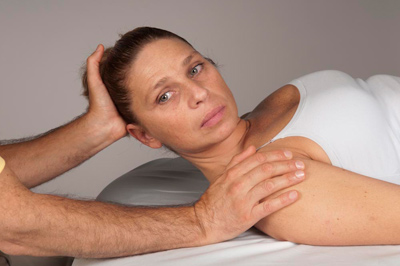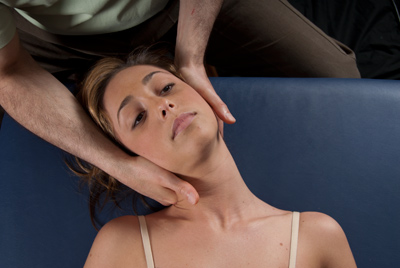 COURSE DESCRIPTION
COURSE DESCRIPTION
Clinical Orthopedic Manual Therapy (COMT) for the Neck covers the major clinical orthopedic assessment and treatment techniques for the neck. This course is a 2-day hands-on workshop.
Day one begins with orthopedic assessment for the common neuromusculoskeletal conditions of the neck. We then cover body mechanics for deep pressure for working the neck in supine, prone, side-lying, ¾ side-lying, and seated positions. With proper body mechanics, you will learn how the neck can be worked deeply with little effort. We also learn how to palpate and safely and effectively work the scalenes and longus musculature of the anterior neck.
Day two covers stretching and Arthrofascial Stretching (AFS): Soft Tissue Joint Mobilization techniques. We begin with basic stretching for the functional muscle groups of the neck and then learn how to target each specific neck muscle with multiplane stretching. We then cover advanced neural inhibition stretching techniques, including Contract Relax (PNF/PIR), Agonist Contract (the basis for AIS), and Contract Relax Agonist Contract stretching techniques. Day two concludes with Arthrofascial Stretching (AFS): Soft Tissue Joint Mobilization for Manual Therapists (including traction) for the cervical spine. AFS is the only effective means of stretching specific hypomobilities of the neck.
Clinical treatment strategy as well as precautions and contraindications are also covered. These manual therapy skills will empower you to do effective clinical orthopedic work. Throughout this hands-on workshop, Dr. Joe Muscolino reinforces the underlying mechanisms for each of the assessment and treatment techniques, encouraging critical reasoning skills.
Clinical Orthopedic Manual Therapy for the Neck is part of the COMT Regional Approach Certification. The other hands-on workshops in this series cover the thoracic spine / ribcage, low back / pelvis, upper extremity, and lower extremity.
COURSE OBJECTIVES
 After attending this workshop, the participant will be able to:
After attending this workshop, the participant will be able to:
Explain and demonstrate the principles of using core body weight and larger muscle groups for efficient body mechanics.
Perform orthopedic assessment tests for the neck to determine the ability to safely perform deep pressure massage, stretching, and Arthrofascial Stretching.
Describe and be able to work the entirely of the scalene group and also access and work the longus colli muscle.
Explain the fundamental concepts of stretching and apply these concepts to the musculature of the neck.
Demonstrate how to stretch each of the functional muscle groups of the neck.
Explain and demonstrate how to stretch each of the muscles of the neck in all three cardinal planes.
Explain the physiologic basis for and demonstrate how to perform contract relax (CR; also known as PIR/PNF) stretching, agonist contract (AC) stretching, and contract relax agonist contract (CRAC) stretching techniques.
Explain the physiologic basis for and demonstrate how to perform Arthrofascial Stretching (AFS, Grade IV joint mobilization) of the neck.
DETAILED TIME LINE
Following is the usual time line for this workshop. Note: This time line is often adjusted as needed based on the needs of the particular group.
DAY ONE:
Introductions: 15 min
- Introduction to the content of the class
- Introduction of instructor and workshop participants to each other
Orthopedic assessment of the neck: 90 min
- Discuss concept of space-occupying conditions (pathologic disc and bone spurs compressing nerves)
- Foraminal compression test
- Maximal foraminal compression test
- Cervical distraction test
- Cough test
- Valsalva maneuver
- Slump test
- Vertebral artery competency test
Break: 15 min
Body mechanics and supine neck work: 90 min
- Work laminar groove musculature
- Orient core in line with stroke
- Keep elbow in
- Stack joints
- Work perpendicular to contour of client’s/patient’s body
- Maintain angle of elbow joint
- Lean in with body weight / core
- Support patient’s head
- Work hands in concert
Body mechanics & prone neck work: 30 min
- Table must be low
- Perform “scoop” stroke ending with cephalad traction of the head
- Use body weight
Lunch: 60 min
Body mechanics side-lying, ¾ side-lying, and seated neck work: 90 min
- Diagonal angle of work for pure side-lying
- Use body weight for ¾ position
- Elbow for ¾ position
- Support head on shoulder for ¾ position
- Work on stretch with head off the end of the table for ¾ position
- Seated position: stabilize client’s/patient’s forehead
- Keep elbow in and stack joints
- Work hands in concert
Working the anterior neck: 60 min
- Use SCM as landmark
- Find lateral border of the clavicular head of SCM and drop laterally onto scalenes
- Work perpendicular
- Slacken with flexion, ipsilateral flexion, and contralateral rotation to work deep to clavicle and SCM for attachments
- Note brachial plexus of nerves
- Find medial border of the sternal head of SCM and drop medially onto longus muscles
- Feel for carotid pulse
- If necessary, gently displace larynx and drop posteriorly for longus musculature
Break: 15 min
Basic stretching (concept and body mechanics): 30 min
- Stretching is a mechanical protocol for making a soft tissue longer
- For a muscle, it involves passively bringing the patient’s neck into a position that is the opposite of its action(s)
- Concept of stabilization: how to figure out how to stabilize
- Introduce concept of functional groups of muscles (right lateral flexors, left lateral flexors, right rotators, left rotators, extensors, flexors)
- Incorporate body mechanics with elbow joint in, stacked joints, and using the core
- Workshop all six functional groups
Multiplane stretching: 30 min
- Begin with functional groups and narrow the scope to be able to target a specific muscle within the functional group
- Consider all planes of motion (i.e., all joint actions) must be considered to optimally stretch a muscle: example: right upper trapezius, right splenius capitis, etc.
Review: 15 min
- Question and answer
- Discuss treatment strategy
DAY TWO:
Introductions: 15 min
- Question and answer over material from Day 1
Review of stretching (basic and multiplane): 30 min
Contract Relax (CR) stretching: 90 min
- Principle of Golgi tendon organ reflex
- Demonstrate CR protocol for lateral flexor group
- Workshop CR technique for each of the major functional groups
- Workshop CR for specific target muscles
Break: 15 min
Agonist Contract (AC) stretching: 90 min
- Principle of reciprocal inhibition reflex
- Demonstrate AC protocol for lateral flexor group
- Workshop AC technique for each of the major functional groups
- Workshop AC for specific target muscles
Lunch: 60 min
Review CR and AC stretching: 15 min
- Question and answer
- Discuss integration of treatment techniques
CRAC stretching: 60 min
- Demonstrate CRAC protocol for lateral flexor group
- Workshop CRAC technique for a few of the major functional groups
- Workshop CRAC for specific target muscles
Overview of Arthrofascial Stretching (AFS, Grade IV joint mobilization): 15 min
- Explain concept of pinning a bone and moving adjacent bone relative to it
- Patient contact: facet
- Therapist contact: index finger pads, thumb pad, radial side of proximal phalanx of index finger
- Steps: 1) Place pin. 2) Bring joint to tension. 3) Mobilize.
- Hold for less than a second, 3-5 oscillations
- Soft tissue pull to trap underlying bone
- Contraindications…
- Use hands in concert
- Utilize body mechanics
Break: 15 min
AFS – supine: 60 min
- Workshop AFS technique with the client/patient supine
- Begin with gentle flowing technique
- Become more focused and assertive
AFS – seated: 30 min
- Stabilization contact on forehead
- “V” contact across facets posteriorly
- mobilize with each lateral flexion motion
- note range of motion higher in neck versus lower in neck
Towel traction: 30 min
- Sagittal stance
- Three steps: 1) Lift anteriorly to grab skin. 2) Lift diagonally to seat towel under occiput. 3) Perform traction by leaning from front foot to rear foot.
- Add in lateral flexion and/or rotation components (change to frontal plane stance)
Review and paperwork: 15 min
- Question and answer
- Fill out evaluation forms
- Hand out Certificates
WORKSHOP PARTICIPANTS SHOULD BRING
1. Massage table with face cradle
2. Stool
3. Bolster and pillow
4. Sheets and face cradle cover
5. King-sized pillow case, preferably flannel (or thin/threadbare bath-sized towel)
6. Water-based lotion
7. Soft foam cushion (approx. 6×10 inches) or bath towel
8. Participants should wear an open-neck shirt that allows access to the neck
Copyright 2014 © The Art and Science of Kinesiology – Dr. Joseph E. Muscolino
